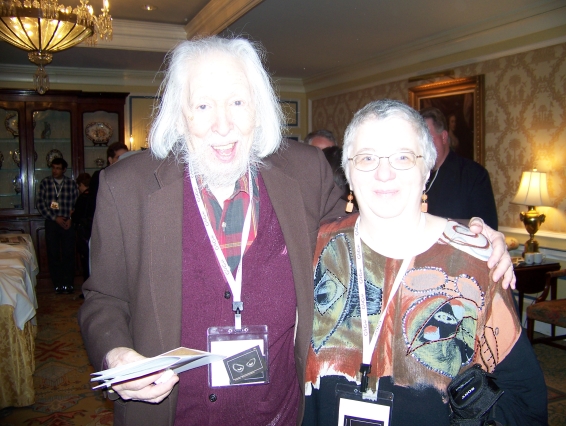Raymond Smullyan’s Magic Trick

I love Raymond Smullyan’s books , especially the trick puzzles he includes. The first time I met him in person, he played a trick on me.
This happened at the Gathering for Gardner 8. We were introduced and then later that day, the conference participants were treated to a dinner event that included a magic show. In one evening I saw more close-up magic tricks than I had in my whole life. This left me lightheaded, doubting physics and my whole scientific outlook on life.
Afterwards, Raymond Smullyan joined me in the elevator. “Do you want to see a magic trick?” he asked. “I bet I can kiss you without touching you.” I was caught off guard. At that moment I believed anything was possible. I agreed to the bet.
He asked me to close my eyes, kissed me on the cheek and laughed, “I lost.”
Share:
Raymond Smullyan:
This proves that it is sometimes worthwhile to lose a bet!
22 December 2010, 7:50 pmTanya Khovanova:
Raymond,
But I was the double winner: I won the bet and got the kiss. Want to bet again?
23 December 2010, 2:58 pmRaymond Smullyan:
You are so sweet!
23 December 2010, 3:41 pmm s dinakar:
I am too far away … in space and in time … still what a lovely blog piece !
14 March 2011, 1:19 amWarm and endearing !
I have admired Raymond Smullyan’s wit and knowledge from afar … and … its nice to discover you … Tanya Khovanova! and your blog …
Beautiful recollection!
Thank you!
donut:
I’m sorry this is off topic, but does anyone know Mr. Smullyan’s email address? (or are you here?) I see that you made 2 comments in December… I was reading the book Chess Mysteries of Sherlock Holmes and the chapter “you really can’t, you know” is driving me crazy as I think there is a mistake but I’m not completely sure and I can’t seem to find Mr. Smullyan’s email address to ask him directly. Thanks.
27 April 2011, 12:53 pmChristian Weidemann:
Donut, yesterday I read the same chapter of “chess mysteries”. I also think there is a flaw. The solution (p.42) says “It [the pawn on a3] must have been from a4”. But that is a non sequitur. It could have been from b4 as well, since Black is to move and the last white move was knight to b4. This possibility completely destroys Sherlock’s conclusion. The problem could, however, easily be repaired, e.g. by letting the white knight and the white king swap places.
21 March 2012, 6:21 amMay be I am overlooking something elementary, but I do not think so.
By the way. This flaw and some other minor inaccuracies notwithstanding the book is absolutely brilliant.